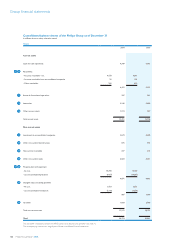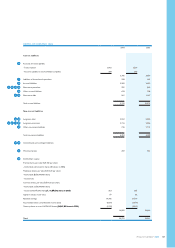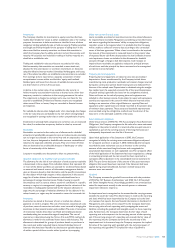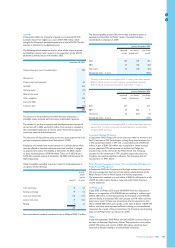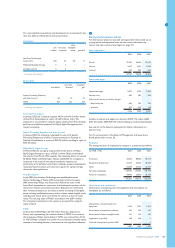Philips 2005 Annual Report Download - page 136
Download and view the complete annual report
Please find page 136 of the 2005 Philips annual report below. You can navigate through the pages in the report by either clicking on the pages listed below, or by using the keyword search tool below to find specific information within the annual report.Philips Annual Report 2005136
determined by allocating the fair value of the reporting unit to all of the
assets (recognized and unrecognized) and liabilities of the reporting unit
in a manner similar to a purchase price allocation upon a business
combination in accordance with SFAS No. 141. The residual fair value
after this allocation is the implied fair value of the reporting unit’s
goodwill. The Company generally determines the fair value of the
reportingunitsbasedondiscountedprojectedcashows.
Intangible assets
Intangible assets arising from acquisitions are amortized using the
straight-line method over their estimated economic lives. Economic
lives are evaluated every year. There are currently no intangible assets
withindenitelives.In-processresearchanddevelopmentwithno
alternative use is written off immediately upon acquisition. Patents and
trademarks acquired from third parties are capitalized at cost and
amortized over their remaining lives.
Certain costs relating to the development and purchase of software for
internal use are capitalized and subsequently amortized over the
estimated useful life of the software in conformity with Statement of
Position (SOP) 98-1, ‘Accounting for the Costs of Computer Software
Developed or Obtained for Internal Use’.
Eligible costs relating to the production of software intended to be sold,
leased or otherwise marketed are capitalized and subsequently
amortized over the estimated useful life of the software in accordance
with SFAS No. 86, ‘Accounting for the Costs of Computer Software to
be Sold, Leased or Otherwise Marketed’.
Impairment or disposal of intangible assets other than goodwill and
tangiblexedassets
TheCompanyaccountsforintangibleandtangiblexedassetsin
accordance with the provisions of SFAS No. 144, ‘Accounting for the
Impairment or Disposal of Long-Lived Assets’. This Statement requires
that long-lived assets are reviewed for impairment whenever events or
changes in circumstances indicate that the carrying amount of an asset
may not be recoverable. Recoverability of assets to be held and used is
measured by a comparison of the carrying amount of an asset with
futurenetcashowsexpectedtobegeneratedbytheasset.Ifthe
carryingamountofanassetexceedsitsestimatedfuturecashows,an
impairment charge is recognized in the amount by which the carrying
amount of the asset exceeds the fair value of the asset. The Company
determinesthefairvaluebasedondiscountedprojectedcashows.The
review for impairment is carried out at the level where discrete cash
owsoccurthatarelargelyindependentofothercashows.Assets
held for sale are reported at the lower of the carrying amount or fair
value, less cost to sell.
Research and development
Costs of research and development are expensed in the period in which
they are incurred, in conformity with SFAS No. 2, ‘Accounting for
Research and Development Costs’.
Advertising
Advertising costs are expensed when incurred.
Provisions and accruals
The Company recognizes provisions for liabilities and probable losses
that have been incurred as of the balance sheet date and for which the
amount is uncertain but can be reasonably estimated.
Provisions of a long-term nature are stated at present value when the
amountandtimingofrelatedcashpaymentsarexedorreliably
determinable unless discounting is prohibited under US GAAP. Short-
term provisions are stated at face value.
The Company applies the provisions of SOP 96-1, ‘Environmental
liabilities’ and SFAS No. 5, ‘Accounting for Contingencies’ and accrues
for losses associated with environmental obligations when such losses
are probable and reasonably estimable. Additionally, in accordance with
SOP 96-1, the Company accrues for certain costs such as compensation
andbenetsforemployeesdirectlyinvolvedintheremediation
activities. Measurement of liabilities is based on current legal
requirements and existing technology. Liabilities and expected insurance
recoveries, if any, are recorded separately. The carrying amount of
liabilities is regularly reviewed and adjusted for new facts or changes in
law or technology.
Restructuring
The Company applies SFAS No. 146, ‘Accounting for Costs Associated
with Exit or Disposal Activities’.
The provision for restructuring relates to the estimated costs of
initiated reorganizations that have been approved by the Board of
Management, and which involve the realignment of certain parts of the
industrial and commercial organization. When such reorganizations
require discontinuance and/or closure of lines of activities, the
anticipated costs of closure or discontinuance are included in
restructuring provisions.
SFAS No. 146 requires that a liability be recognized for those costs re
onlywhentheliabilityisincurred,i.e.whenitmeetsthedenitionof
a liability. SFAS No. 146 also establishes fair value as the objective for
initial measurement of the liability.
Liabilitiesrelatedtoone-timeemployeeterminationbenetsare
recognized ratably over the future service period when those
employees are required to render services to the Company, if that
periodexceeds60daysoralongerlegalnoticationperiod.
Employeeterminationbenetscoveredbyacontractorunderan
ongoingbenetarrangementcontinuetobeaccountedforunderSFAS
No.112,‘Employer’sAccountingforPostemploymentBenets’andare
recognized when it is probable that the employees will be entitled to
thebenetsandtheamountscanbereasonablyestimated.
Guarantees
The Company complies with FASB Interpretation No. 45, ‘Guarantor’s
Accounting and Disclosure Requirements for Guarantees, including
Indirect Guarantees of Indebtedness of Others’. In accordance with this
Interpretation, the Company recognizes, at the inception of a guarantee
that is within the scope of the recognition criteria of the Interpretation,
a liability for the fair value of the obligation undertaken in issuing the
guarantee.
Debt and other liabilities
Debt and liabilities other than provisions are stated at amortized cost.
However, loans that are hedged under a fair value hedge are remeasured
for the changes in the fair value that are attributable to the risk that is
being hedged.
Currently,theCompanydoesnothaveanynancialinstrumentsthatare
affected by SFAS No. 150 ‘Accounting for Certain Financial Instruments
with Characteristics of both Liabilities and Equity’.
Revenue recognition
The Company recognizes revenue when persuasive evidence of an
arrangement exists, delivery has occurred or the service has been
provided,thesalespriceisxedordeterminable,andcollectibilityis
reasonably assured. For consumer-type products in the segments
Lighting, DAP and Consumer Electronics, as well as for certain products
in the Semiconductors segment, these criteria are generally met at the
time the product is shipped and delivered to the customer and,
depending on the delivery conditions, title and risk have passed to the
customer and acceptance of the product, when contractually required,
has been obtained, or, in cases where such acceptance is not contractually
required, when management has established that all aforementioned
conditions for revenue recognition have been met and no further post-
shipment obligations exist. Examples of the above-mentioned delivery
conditions are ‘Free on Board point of delivery’ and ‘Costs, Insurance
Paid point of delivery’, where the point of delivery may be the shipping
warehouse or any other point of destination as agreed in the contract
with the customer and where title and risk in the goods pass to
the customer.
For products that require substantive installation activities by the
Company, such as those related to the equipment sales of the Medical
Systems segment and parts of the Other Activities segment, revenue
Groupnancialstatements


